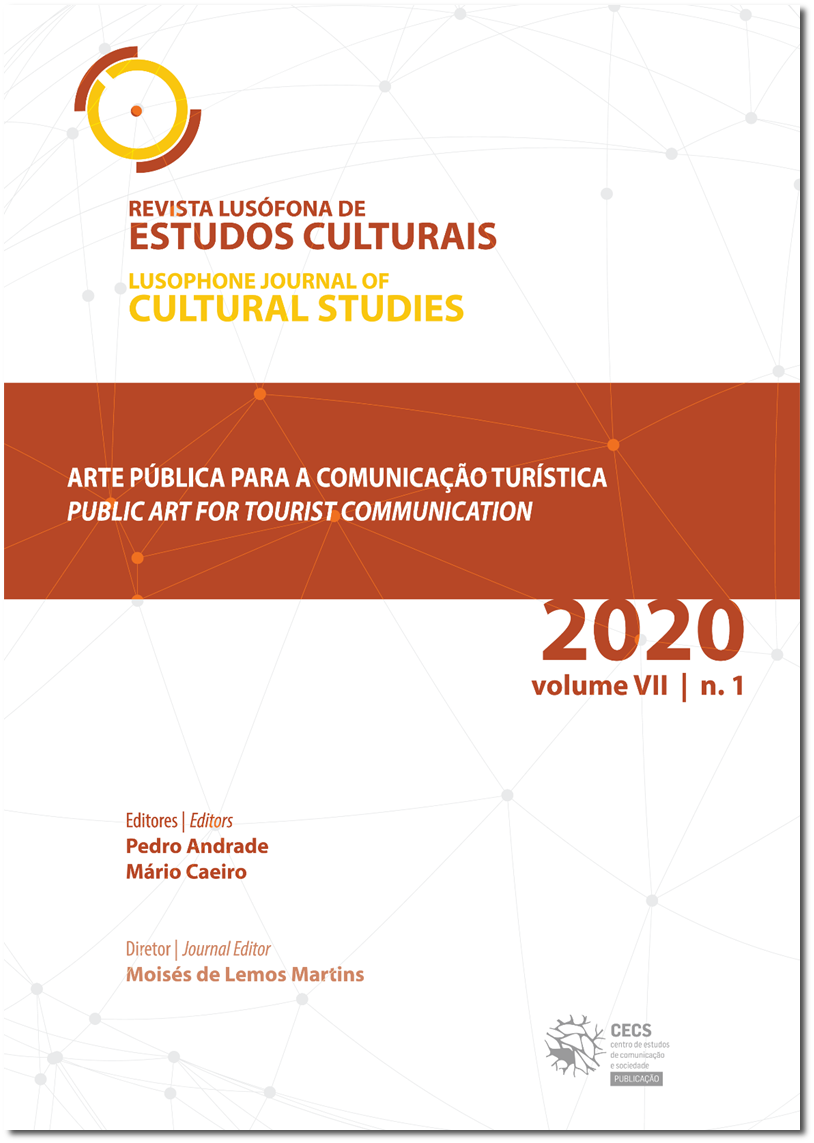Introductory note: public arts for tourism communication?
DOI:
https://doi.org/10.21814/rlec.2665Abstract
Public art, in addition to the intentions expressed in its production and writing by the respective artists, or beyond its consumption and interpretation by its audiences, is also understood within the context of the mediation processes between its creation and viewing. Such intermediation is activated by various communication contexts – such as a museum or an event in an urban street or square. Public art is communicated within multiple spheres of the urban public space. In other words, public art extends, and is understood together with (is founded on, and merged with) other social processes, in different ways, according to the type of social environment in which a public art work occurs. For example, a public work of art can articulate or combine socioeconomic, political and cultural dimensions...Downloads
References
Alvarez, M., Yüksel, A. & Go, F. (Eds.) (2016). Heritage tourism destinations: preservation, communication and development. Wallingford: CABI.
Andrade, P. (2020). Cultural tourism and mobile digital devices: an analysis of tourists in Lisbon through sociological comics and video paper. In C. Sarmento & M. Quincé (Eds.), Intercultural routes across multicultural spaces: from theory to dialogue (pp. 39-56). Porto: Centro de Estudos Interculturais.
Andrade, P. (2015). Austerity (Hi)story through sociological comics: a guide to social media and networks against austeritocracy for use by all generations. North Charleston: Create Space.
Andrade, P. (2010). Introdução. In P. Andrade, C. Marques & J. Barros (Eds.), Arte pública e cidadania: novas leituras da cidade criativa cidade (pp. 13-30). Lisboa: Caleidoscópio.
Bendel, P. (2012). Its a crisis! NOW what? The first step-by-step crisis communications handbook for the global tourism and hospitality professional. Toronto: Sutherland House Publishing.
Boomgaard, J. (2017). Being public: how art creates the public. Amsterdão: Valiz.
Burton, J. (2016). Public servants: art and the crisis of the common good. Cambridge: The MIT Press.
Caeiro, M. (Ed.) (2019). Vicente símbolo de Lisboa: mito contemporâneo. Lisboa: Theya Editores.
Caeiro, M. (2014). Arte na cidade. Lisboa: Temas e Debate.
Campos, R. (2010). Porque pintamos a cidade? Uma abordagem etnográfica do graffiti urbano. Lisboa: Fim de Século.
Campos, R., Brighenti, M. & Spinelli, L. (Eds.) (2011). Uma cidade de imagens: produções e consumos visuais em meio urbano. Lisboa: Editora Mundos Sociais.
Correia, M., Pires, H. & Andrade, P. (2017). Passeio, passante, passeante. Uma plataforma de arte e cultura urbana. Revista Lusófona de Estudos Cuturais, 4(1), 167-201. https://doi.org/10.21814/rlec.184
Cartiere, C. (2016). The everyday practice of public art: art, space, and social inclusion. Londres: Routledge.
Doherty, C. (2015). Out of time, out of place: public art (now). Londres: Art Books Publishing.
Evans, F. (2018). Public art and the fragility of democracy: an essay in political aesthetics. Nova Iorque: Columbia University Press.
Fenner, F. (2017). Running the city: why public art matters. Kensington: New South Publishing.
Francesconi, S. (2014). Reading tourism texts: a multimodal analysis. Bristol: Channel View Publications.
Getz, D. (2013). Event tourism: concepts, international case studies and research. Putnam Valley: Cognizant Communication Corporation.
Getz, D. (2005). Event management and event tourism. Putnam Valley: Cognizant Communication Corporation.
Grams, D. & Farrell, B. (2008). Entering cultural communities: diversity and change in the nonprofit arts. New Brunswick: Rutgers University Press.
Huebner, J. (2019). Walls of prophecy and protest: William Walker and the roots of a revolutionary public art movement. Evanston: Northwestern University Press.
Jaworski, A. & Pritchard, A. (Eds.) (2011). Discourse, communication and tourism. Channel. Bristol: View Publications.
Minazzi, R. (2014). Social media marketing in tourism and hospitality. Berlim: Springer.
Neidhardt, J. & Wörndl, W. (Eds.) (2020). Information and communication technologies in tourism 2020: proceedings of the International Conference in Surrey, United Kingdom, January 08-10. Berlim: Springer.
Pezzullo, P. (2009). Toxic tourism: rhetorics of pollution, travel, and environmental justice. Tuscaloosa: University of Alabama Press.
Pinder, K. (2016). Painting the gospel: black public art and religion in Chicago. Champaign: University of Illinois Press.
Rupp, J. (2018). Art in Seattle’s public places: an illustrated guide. Seattle: University of Washington Press.
Sharda, N. (2010). Tourism informatics: visual travel recommender systems, social communities, and user interface design. Hershey: IGI Global.
Stern, N. (2018). Ecological aesthetics: artful tactics for humans, nature, and politics. Chicago: University of Chicago Press.
Stoyan, R. (2019). Tourism and intercultural communication and innovations. Cambridge: Cambridge Scholars Publishing.
UNWTO, World Tourism Organization. (2011). Toolbox for crisis communications in tourism: checklist and best practices. Madrid: World Tourism Organization.
UNWTO, World Tourism Organization. (2005). Observations on international tourism communications Asia and the Pacific: report from the Regional Conference on Tourism Communications. Madrid: World Tourism Organization.
Downloads
Published
How to Cite
Issue
Section
License
Authors own the copyright, providing the journal with the right of first publication. The work is licensed under a Creative Commons - Atribuição 4.0 Internacional License.












